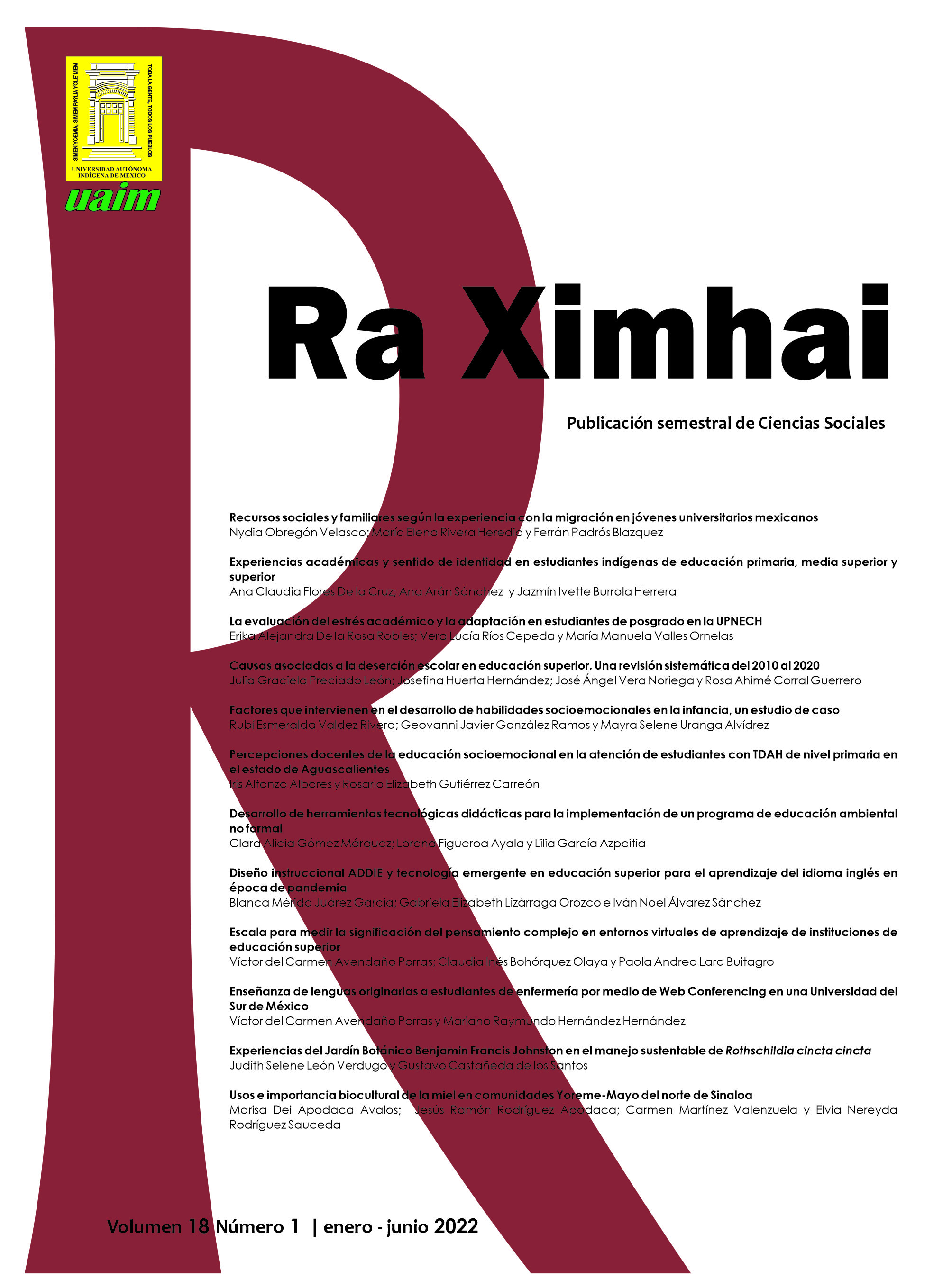Experiences of the Benjamin Francis Johnston Botanical Garden in the sustainable management of Rothschildia cincta cincta
DOI:
https://doi.org/10.35197/rx.18.01.2022.11.jsKeywords:
Rothschildia cincta cincta, zoo breeding farm, conservation, tenábari, bioculturalityAbstract
In the state of Sinaloa, México, butterfly four mirrors (Rothschildia cincta cincta) has a wide distribuition adjoining with Nayarit on the south and with Sonora on the north side, in which región manifests an ingrain with ethnicity Yoreme-Mayo since they use the cocoons produced by the butterfly for the elaboration of tenábaris as part of their costume, that gives them identity and belonging. However, in the last years it has been observe dan increase on the vulnerability of the specie due to anthropogenic pressure which incise with the land-use change, the excessive extraction of cocoons, coupled with the natural changes that are exerted in these ecosystems. For those reasons, it is important to perform strategies that promote its conservacy as well as the prevalescency of the biocultural richness on the region.
The present work exposes the experiences of Botanical Garden Benjamín Francis Johnston in the study of Rothschildia cincta cincta in wildlife, as well as its behaviour in captivity. During seven uninterrupted years, we have been stablished a methodology for the reproduction ex situ in this botanical garden and it has been documented the wildlife population status in a few areas in Ahome, Sinaloa; moreover, we have replicated his reproduction in indigenous communities and the documented information has been divulgated to society.
The contribuition of scientific information must have an impact with the public politics such as NOM-059-SEMARNAT-2010, which permit the implement strategies of sustainable management of vulnerable species and value this sites as a priority areas for the conservacy of biocultural richness.
Downloads
References
Castañeda, G. (2019). Plan estratégico de educación ambiental para el Centro de Educación y Cultura Ambiental (CECA) del Jardín Botánico “Benjamin Francis Johnston” en los Mochis, Sinaloa. Tesis de maestría. Universidad de Guadalajara. Jalisco. Disponible en: https://www.riudg.udg.mx/handle/20.500.12104/81108.
Compeán, M. (2012). Jardín Botánico Benjamín Francis Johnston. Quid Media Services S.A. de C. V. México D. F.
DOF, (2019). Modificación del anexo Normativo III, lista de especies en riesgo de la Norma Oficial Mexicana NOM-059-SEMARNAT-2010. Recuperado en: https://www.dof.gob.mx/nota_detalle.php?codigo=5578808&fecha=14/11/2019
López, C.A. (2013). Atlas Yoreme del municipio de Ahome. Consejo Ciudadano para el Desarrollo Cultural del Municipio de Ahome.
Márquez- Salazar, G., Salomón- Montijo, B. & Romero- Higareda, C., 2014. Dinámica Poblacional le larvas de Rothschildia cincta cincta (Lepidoptera: Saturniidae) entre áreas de presencia y ausencia de colectores de capullos. Disponible en: http: //sistemanodalsinaloa.gob.mx/archivoscomprobatorios/_14_resumeneventoscientificos/3299.pdf.
Márquez- Salazar, G., Salomón-Montijo, B., Sánchez-Bañuelos, R., Cabrera-Flores, C., Gamez-Duarte, E., Robles-Medina, C., Medina, K. y Burgueño-Hernández, D. (2010). LA MARIPOSA DE LOS TÉNABARIS (ROTHSCHILDIA CINCTA): CULTURA, BIOGEOGRAFÍA Y ECOLOGÍA. Universidad Autónoma de Sinaloa. Recuperado de: https://www.academia.edu/27155287/LA_MARIPOSA_DE_LOS_T%C3%89NABARIS_ROTSCHILDIA_CINCTA_CULTURA_BIOGEOGRAF%C3%8DA_Y_ECOLOG%C3%8DA.
Márquez, S. G. et al. (2007). “Manejo de capullos de Rothschildia cincta por los Yoreme-Mayos del norte de Sinaloa, México”. MESOAMERICANA, 11, 79.
Moctezuma, J. L. y López, H. (2007). Mayos, Pueblos Indígenas del México contemporáneo. Comisión Nacional para el Desarrollo de los Pueblos Indígenas. México. 55p. Disponible en. https://www.gob.mx/cms/uploads/attachment/file/11675/mayos.pdf
Peigler, R. S. y P. A. Opler (1993). Moths of West North America. C. P. Guillette Insect Biodiversity Museum. Deparment of Entomology, Colorado State University.
Piegler, R. S. y M. Maldonado, (2005). “Uses of cocoons of Eupackardia calleta and Rothschildia cincta (Lepidoptera: Saturniidae) by Yaqui Indians in Arizona and México”. Nachr. Entomol. Ver. Apollo. N. F. 26, 111-119.
Salomón-Montijo, B. & Márquez-Salazar, G., 2015. MÉTODO DE EVALUACIÓN DEL RIESGO DE LA PALOMILLA CUATRO ESPEJOS (Rothschildia cincta cincta) (TEPPER, 1883) (LEPIDOPTERA: SATURNIIDAE) EN MÉXICO. Juyyaania, 3(1), pp. 25-39.
Vásquez, L.M. (2008). Comparación de dos métodos de muestreo para el estudio de la comunidad herbácea de Las Lomas. Zonas áridas, 12(1) ,167-183.
Downloads
Published
How to Cite
Issue
Section
License
Copyright (c) 2022 Judith Selene León Verdugo, Gustavo Castañeda de los Santos

This work is licensed under a Creative Commons Attribution-NonCommercial 4.0 International License.
Usted es libre de:
- Compartir — copiar y redistribuir el material en cualquier medio o formato
- Adaptar — remezclar, transformar y construir a partir del material
- La licenciante no puede revocar estas libertades en tanto usted siga los términos de la licencia
Bajo los siguientes términos:
- Atribución — Usted debe dar crédito de manera adecuada , brindar un enlace a la licencia, e indicar si se han realizado cambios . Puede hacerlo en cualquier forma razonable, pero no de forma tal que sugiera que usted o su uso tienen el apoyo de la licenciante.
- NoComercial — Usted no puede hacer uso del material con propósitos comerciales .
- No hay restricciones adicionales — No puede aplicar términos legales ni medidas tecnológicas que restrinjan legalmente a otras a hacer cualquier uso permitido por la licencia.








